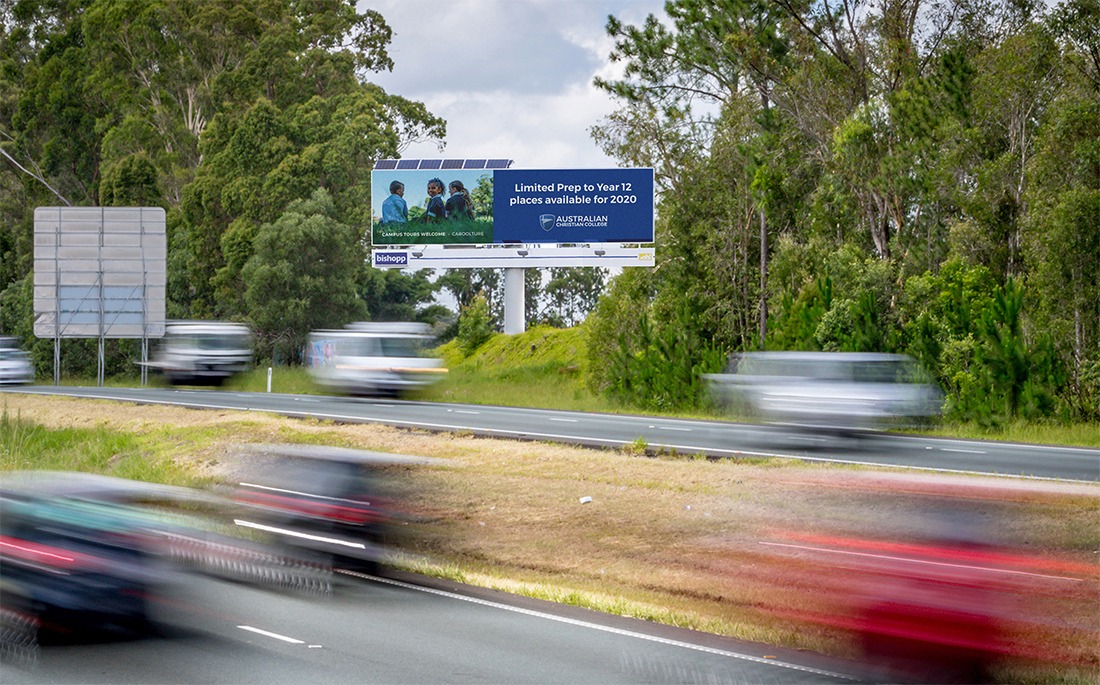Billboard Advertising Actually Works —
Here’s Proof from Australian Christian College
Australian Christian College at Caboolture has been advertising on Bishopp billboards for more than three years. In this article and case study, their marketing director outlines why billboard advertising works and the results they have achieved from their school billboard campaign.
Billboard advertising works in a digital world
Let me start by outlining three practical reasons why billboard advertising still works today, even though most traditional forms of advertising have been declining.
Firstly, people are driving cars at a similar frequency to pre-internet. In other words, the web hasn’t replaced driving. So, assuming your billboards are on roadsides, they will attract eyeballs.
Secondly, schools require students to arrive onsite at the start of the day and leave mid afternoon. There is a localness to schools which makes proximity important. For this reason, it makes sense to concentrate your marketing efforts within the catchment zone of your school. Billboards well positioned within your school’s catchment zone ticks that box. A similar argument can be made for local service businesses, such as hairdressers, personal trainers and cafes.
Lastly, an integrated marketing campaign is still best, as humans’ brains are largely wired the same way as pre-internet. It takes people a few exposures before they receive a marketing message. And it turns out that if these exposures are via different channels, the effectiveness increases. Integrating new and old media to generate exposure leads to enquiry.
The School Billboard Campaign That Generated $239,530 in Net Revenue
Actually, $239,530 is conservative as it assumes the new student enrolments generated only remained at the school for one year. Which is highly unlikely.
In the spirit of transparency, here’s how I derived that figure. The billboard campaign (site hire charges) cost $22,520 for 12 months. We have an inhouse graphic designer who spent 3 hours on the artwork at an estimated charge-out rate of $150 per hour and an amateur photographer at our school took the photo at no cost. So the total cost of the campaign was $22,970.
On the revenue side, the campaign generated 21 new enrolments. As a rule of thumb, each student attracts about $10,000 in government funding per year. As a low-fee school, I averaged the school fees (as they scale up with year levels) to be $2,500 per student, which equates to $52,500. And so the campaign generated an additional $262,500 in revenue:
(21 enrolments x $10,000 = $210,000) + (21 enrolments x $2,500 = $52,500) = $262,500
Subtract the $22,970 in costs from the $262,500 in revenue and you have a net revenue position of $239,530. Now, if you replicated those results at a high-fee school or a business selling high-ticket goods such as cars, your outcome would be even better!
Some considerations
The outlying suburbs that we wanted to target just so happened to have billboards on the major arterial roads connecting with our school. You’ll understand shortly what I mean.
The map below (with modifications for confidentiality reasons) shows our enrolment along these arterial roads before the billboard campaign. The two clusters of dots (one to the east and one to the west) were the target suburbs.

The map below shows the impact on enrolment at the conclusion of the 12 month billboard campaign.

Interestingly, we only received 7 enrolment applications during the campaign period noting ‘billboard’ as the source of enquiry. But as any experienced marketer knows, this information should be viewed as the tip of the iceberg and taken into account with other supporting evidence. For example, if you’re running Facebook ads and enquirers keep mentioning the specific call to action wording used in the ads, but nobody is noting Facebook as their enquiry source on applications you shouldn’t conclude that the Facebook campaign was unsuccessful. You should dig deeper.
In the case of our billboard campaign, we realised that the growth in student numbers along those arterial roads was best attributed to the billboards. You see, we weren’t running any brand awareness advertising nor any other form of targeted marketing into those areas. It had to be the billboards. (Well actually, it could have been word of mouth, but the rate of WOM in those two areas would have far outstripped the average WOM rate across our parent body).
Billboard Advertising Isn’t Rocket Science
The billboard design was simple: a 4-word headline, a photograph of a student and our school logo. (If I showed you the design, you’d be like, pfft, that’s nothing special!)
Your school or local business should consider billboard advertising as part of your marketing plan. Will it work? Well, it depends on your budget, objectives, messaging, design, reputation, enquiry handling efficiency and billboard location. This reality was driven home to me when someone informed me that prior to my employment this same school had run a billboard campaign with zero result. When reviewing what had been done previously, it was clear that it was the wrong message, on the wrong billboard, with the wrong design (for example, they had used the web address as the ‘headline’ of the billboard).
Like all marketing, billboard advertising isn’t a silver bullet, but it worked for us (the second time around anyway). Maybe it will work for your school or business too.
About the author
David Garden is a school marketer with 20+ years experience and an MBA (Marketing). David also has 20+ years experience at marriage and is blessed to raise two daughters with his wife. He is currently Marketing Director for the Australian Christian College Group. You can connect with David on LinkedIn.

